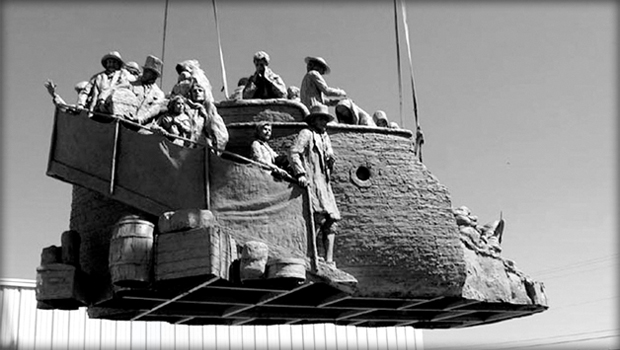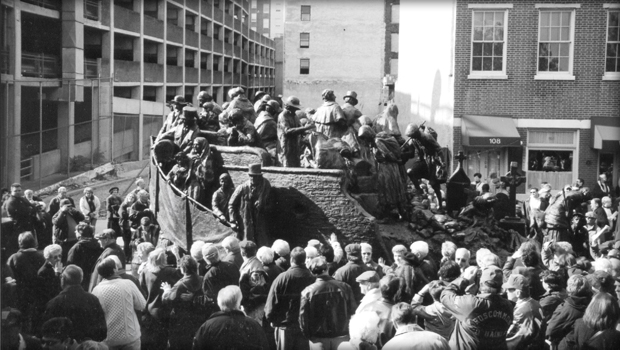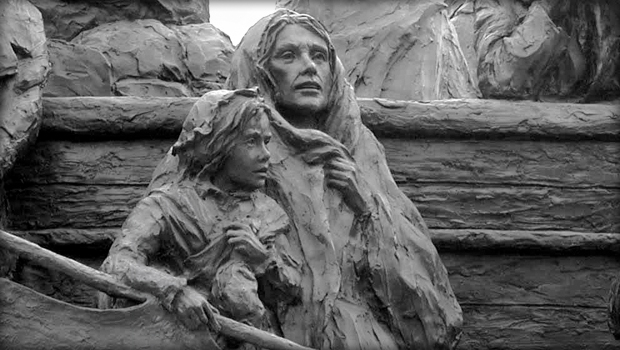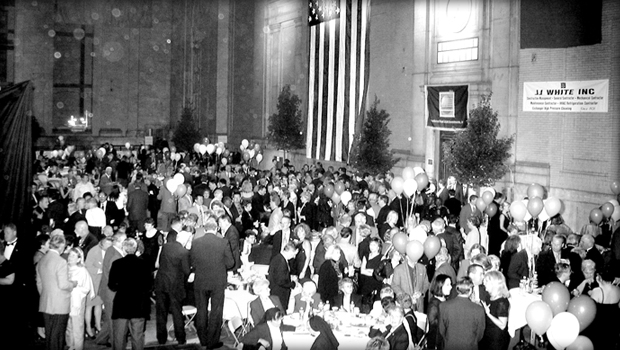
At Castings of Colorado in Loveland, CO, as the
newly-cast Memorial was being removed from the foundry and placed on the truck for shipment to Philadelphia in September 2002.
By Marita Krivda Poxon
A splendid afternoon and evening occurred on Saturday, October 26th, 2013 when the Board of Directors of the Irish Memorial Inc. and numerous supporters gathered at Penn’s Landing to celebrate the 10th Anniversary of the Irish Memorial national monument. Present, of course, was James Coyne, current emeritus president, called by today’s Board of Directors “The Father of the Irish Memorial.”
Jim Coyne has been central to this massive bronze sculpture’s creation and continued pristine existence. He along with Irish historian Dr. Dennis Clark conceived the idea in the early 1990s. Both men dreamed of a memorial to the one million plus Irish who starved to death during The Great Hunger (An Gorta Mor) 1845-1850. In front of the bronze monument, Coyne beamed with pride at the ceremony and later at the gala dinner dance at the nearby Society Hill Marriot Hotel.
Few understand that the monumental bronze needs constant upkeep better than Jim Coyne. To get the sculpture ready for the October 2013 rededication ceremony, Coyne along with the board raised over $30,000 for the repair of the bronze piece, the two carved standing stones, and the eight marble and granite “Great Hunger” information stations in the park. Sandblasting, cleaning and stonework made the monument as good as new under the direction of fellow board member, Michael J. Flynn. He also has served as the site construction manager working closely with Coyne.
Additionally Coyne makes sure that the 1.75 acre landscaped park’s plants are thriving. For 10 years, the gardens have been restocked with Native American plants which complement the story of the monument itself. On the monument’s west side are Native American plants and on its east side are green plants native to Ireland.
Santa Fe-based artist, Glenna Goodacre, sculpted the Irish Monument. It is 12 feet high, 30 feet long and 12 feet wide resting on a concrete plinth 2 feet high. The monument has the basic look of a large wedge. The east end of the monument contains a landscape of Ireland filled with gaunt, starving figures. The west end, portrays a ship filled with hope filled immigrants as they dock in the Philadelphia Harbor with the Greeter figure waving to the disembarking passengers. The monument has 30 life-sized figures.
Present at the rededication ceremony were more than one hundred persons from various Ancient Order of the Hibernians divisions and representatives of the Society of the Friendly Sons of Saint Patrick including John Donovan and current president, Francis J. Moran. John F. Donovan, Coyne’s son-in-law, has served on the Irish Memorial Board as its secretary and treasurer. Frank J. Moran has served as general counsel since its inception. Rev. Nicholas S. Rashford, S.J., former president of St. Joseph’s University, gave the invocation just as he had done 10 years ago at the opening ceremony.
Coyne generously credits Dr. Dennis Clark, the Society of the Friendly Sons of St. Patrick’s historian, with the original idea. Clark died in 1993 before the Irish Memorial became a reality. But it was Coyne himself who made their joint dream a reality. Under his leadership their dream was built. Philadelphia’s Irish Memorial has become a national monument for the great Irish starvation.
 In the early 1990s there was only one existent monument to An Gorta Mor in the world. That was on Grosse Isle, Quebec, Canada, where the Ancient Order of the Hibernians erected a large Celtic cross on the island in the St. Lawrence River in 1909. Coyne convinced the Friendly Sons of St. Patrick to back the Irish Memorial project when he asked the Board to write a sentence or two about the Great Hunger.
In the early 1990s there was only one existent monument to An Gorta Mor in the world. That was on Grosse Isle, Quebec, Canada, where the Ancient Order of the Hibernians erected a large Celtic cross on the island in the St. Lawrence River in 1909. Coyne convinced the Friendly Sons of St. Patrick to back the Irish Memorial project when he asked the Board to write a sentence or two about the Great Hunger.
When the answers were read out all were embarrassed at the lack of understanding about the historic reality of the Great Hunger. All realized that there was a great need for education in America about this intentional genocide. Coyne rallied the Philadelphia Irish to call the Potato Famine, The Great Hunger or in Irish, An Gorta Mor.
He said, “How can the failure of one crop constitute a famine? There was no scarcity of food; the country was still exporting food. The potato blight struck all over Europe…but nowhere was it as devastating as in Ireland. The English stole land from the Irish and pushed them ‘to hell or Connaught.’ Tenant farmers could barely subsist after turning over most of their produce to absentee landlords.”
The Friendly Sons pledged $100,000 and over 10 years Jim Coyne and his board raised over three million. The donors to this great cause have included the Connelly Foundation, J.J. White, Inc., the J. Maxwell Moran Family, the Independence Foundation and generous support garnered from the taxpayers by Governor Edward Rendell.

The Irish Memorial is being unveiled at the Gala Unveiling and fundraiser at Michael O’Neil’s “The Wharf at Rivertown” in Chester, PA on October 19th, 2002. In the foreground are James Coyne and Glenna Goodacre, sculptor. Pictured behind them on the stage are Tom O’Malley and John Luke, directors of the Memorial. The event raised $500,000 for the Memorial.
The Irish Memorial website, www.irishmemorial.com, includes categories: Book of Kells Sponsors, Irish Caucus Sponsors, Tara Brooch Sponsors, and An Gorta Mor Sponsors.
Coyne said that work on The Irish Memorial has changed his life. A great deal of the past 20 years of his life has been consumed with this work, which he said, has been a labor of love. He said he and the early board could not have envisioned exactly how brilliantly the execution of the Memorial would have turned out. Once they selected Glenna Goodacre as the sculptor the artistic vision soon grew to the point that even for the artist, it is her largest work of public art. And of course Coyne is proud to say that the Irish Memorial has been the grandest monument that the Philadelphia Irish community has ever constructed.
Coyne’s position as emeritus president still keeps him deeply involved in countless fund-raising activities including the quarterly flag raising ceremonies where new Irish and American flags replace weather-beaten older flags – the honor given to generous donors. Numerous Irish Memorial fundraisers have occurred throughout the years including 5k runs.
Current Irish Memorial president, Kathleen Sullivan, former city representative under Philadelphia Mayor Ed Rendell, has summoned up what many in the Philadelphia Irish community think of Jim Coyne:
“The Irish community is indebted to Jim Coyne for his commitment to honoring our Irish ancestors and educating the citizens of Philadelphia and the Delaware Valley on the real truth about An Gotra Mor, the Great Hunger that devastated Ireland in the mid-19th century. And I will be forever thankful that I had the opportunity to work with Jim to bring the Irish Memorial to Philadelphia, a sculpture that has made a profound contribution to Philadelphia’s artistic landscape.
“Jim is our historian and our professor — he transmits his passion for our heritage; he makes us want to find out more about our past, as well as keep alive all of those wonderful Irish traditions. Our Board calls him “
” — a title that is well-deserved.”



